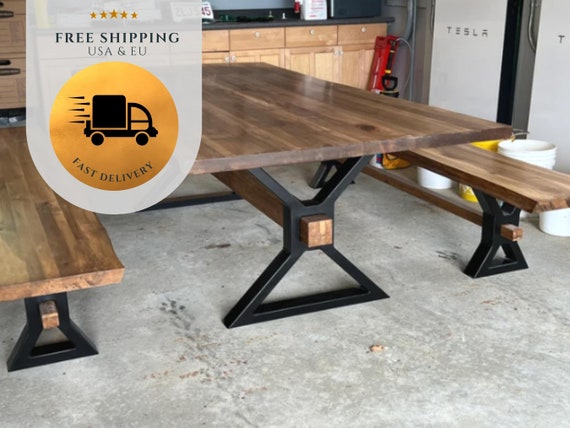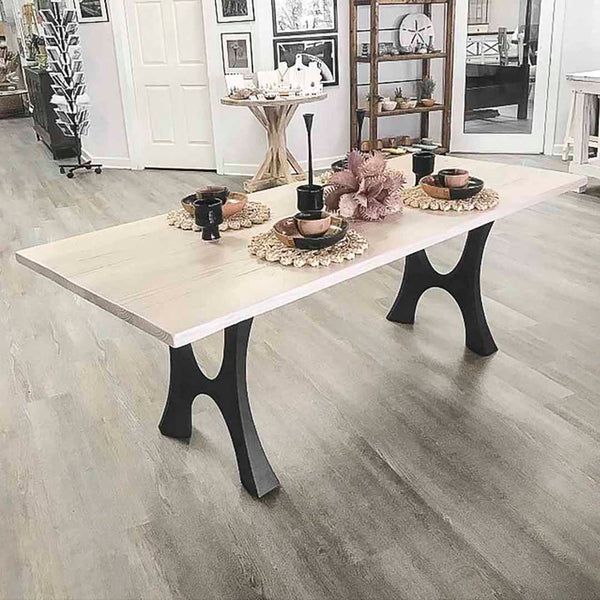How the Right Dining Room Table Legs Can Complete Your Dining Room Look
Expert Tips for Installing Dining-room Table Legs for Maximum Stability
When it comes to setting up eating room table legs, achieving maximum security is extremely important for both performance and looks. What particular methods can enhance security also further?
Pick the Right Legs
When selecting the suitable legs for your eating space table, it is vital to take into consideration both functionality and aesthetic appeals. The legs you select will significantly impact the overall design and security of the table. Initially, examine the table's meant usage; if you anticipate regular celebrations, stronger legs, such as those made from strong wood or steel, may be much more ideal, as they use enhanced durability and assistance.
Conventional dining tables normally vary from 28 to 30 inches in elevation, so make sure the legs align with this requirement for comfort. Conical legs can add a contemporary touch, while turned legs might share a much more traditional visual.

Select Appropriate Equipment
Exactly how can the ideal equipment boost the stability and long life of your dining-room table? The choice of proper hardware is vital to guaranteeing that the legs of your table are securely affixed and able to endure routine use. Top notch screws, bolts, and brackets offer the needed stamina to sustain the weight of the table, along with any extra loads positioned upon it throughout dishes or events.
When selecting screws, opt for those made from durable products such as stainless steel or brass, which stand up to rust and maintain integrity gradually. The length of the screws is similarly crucial; they need to pass through deeply into the table's framework without jeopardizing stability. For bolted connections, consider using lock washers to stop loosening up because of vibration or motion.
Furthermore, using corner brackets can include added assistance, particularly for larger tables or those with heavier tops. These brackets disperse weight evenly and help keep the table's shape. Guaranteeing that the hardware you pick is ideal for the specific products of your table will further boost its overall security and durability, permitting you to appreciate your eating experience for years to find.
Ensure Correct Placement
Proper placement of eating space table legs is crucial for both visual allure and useful stability. Misaligned legs can cause an uneven table top, which might not only be visually unappealing yet also endanger the table's usability. To attain optimum placement, begin by measuring the range from the table's edges to the leg attachment points. This makes certain that each leg is located equidistant from the edges, producing a balanced appearance.
Use a level throughout installation to confirm that each leg is perpendicular to the tabletop. This action is critical, as also small inconsistencies can intensify into considerable stability problems in time. It is recommended to note the wanted leg positions on the bottom of the table with a pencil or concealing tape before securing them. This technique works as an aesthetic overview, permitting for changes as required.
Furthermore, verify the placement after the initial screws are tightened up, as adjustments might be required prior to totally protecting the hardware. By focusing on proper alignment, you not only enhance the table's general design yet also ensure that it stays stable and useful for many her response years ahead.

Consider Weight Circulation
After making sure appropriate placement of the dining area table legs, it is necessary to take into consideration weight distribution to enhance stability and capability. dining room table legs. Proper weight circulation is vital in preventing tottering and ensuring that the table can sustain its desired load without danger of tipping or falling down
When placing the legs, guarantee they are positioned at equal distances from the facility of the table to equally disperse the weight across the structure. Consider the weight of the tabletop and any type of products that will regularly hinge on it, such as decorative items or tabletop devices. Tables with heavier surfaces ought to ideally have legs located closer to the edges, as this takes full advantage of the base of assistance and minimizes the risk of instability.
Furthermore, if the table is intended for usage in a high-traffic area, think about making use of heavier materials for the legs or including stabilizing components, such as cross-bracing or a lower shelf - dining room table legs. These changes can help maintain equilibrium and prevent moving during usage. Inevitably, a well-considered weight circulation method will significantly enhance the table's total efficiency, ensuring it stays a useful and appealing centerpiece for your eating space
Examination Stability Prior To Usage
Examining the stability of the dining area table before usage is a critical step that should not be ignored. If the table shows instability, identify the legs or joints that might need adjustment.
Following, examine that all fasteners and screws are tightened effectively. Loose connections More Bonuses can bring about instability and possible damage over time. If essential, utilize wood glue on joints to improve stability, making sure to enable ample drying out time.

Final Thought
To conclude, the installment of eating area table legs needs mindful consideration of materials, positioning, weight, and equipment circulation websites to accomplish optimum stability. By picking high-quality bolts and tough legs, making sure precise alignment, and distributing weight equally, the structural stability of the table can be significantly enhanced. Performing a security test before routine use better ensures that the table will withstand everyday stress, thus providing a secure and reputable eating experience.
When it comes to setting up dining area table legs, accomplishing optimum security is critical for both capability and visual appeals. The legs you pick will substantially influence the general design and security of the table (dining room table legs). Common dining tables usually vary from 28 to 30 inches in elevation, so make sure the legs align with this criterion for comfort.Appropriate positioning of dining area table legs is crucial for both aesthetic charm and useful security.In verdict, the setup of dining area table legs calls for careful consideration of products, weight, positioning, and equipment circulation to achieve optimum stability